Featured Sculptures
Venus Marina
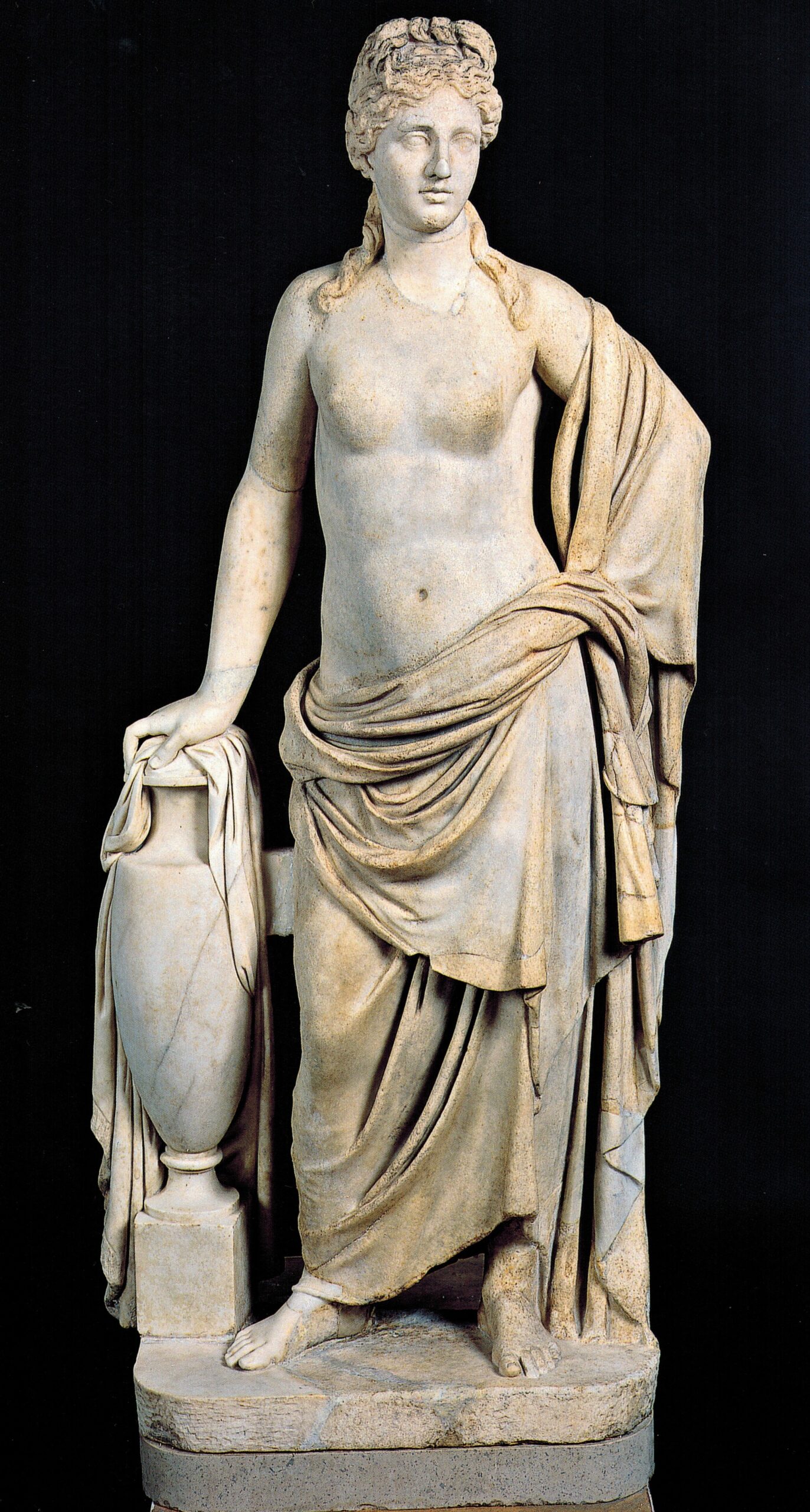
Hope’s Venus Marina, likely acquired at the sale of the Duke of St. Alban’s collection in 1801, is a Roman sculpture dating from the mid-second century, thought to derive from an original Greek Aphrodite of the fourth century BC. It was restored in the workshop of Bartolomeo Cavaceppi, who was the most prominent and prolific restoration artist of eighteenth-century Rome, and included in illustrations he published in 1768. He appears however to have made only minor repairs to this statue, in addition to re-securing the head.
In keeping with the representational traditions associated with the figure of Aphrodite, the marble is markedly divided in terms of nudity and drapery. The upper portion, the torso, is naked, while the lower portion is covered by swirling cloth that snakes back up and across her back and shoulders. Most of her weight rests on her left foot, while her right arm is supported by a pillar and vase. The statue’s head inclines to the viewer’s right, creating a coiffure reminiscent of the famous Aphrodite in the Capitoline in Rome. Hope’s copy demonstrates a prior separation between the head and torso, with a slightly visible seam; however, the fact they are composed of the same material, in the same fashion and condition, and that the tresses in the hair align, indicates they are of the same origin and that this separation was probably accidental. For all the vigor evident in the sculptor’s approach, however, there is some disregard for anatomical detail. The draperies, for example, are swathes and pleats of flat stone that do not entirely conform to her body, but create a vertical column on her left side that offers a visual counterpart to the supports on her right, thus ‘framing’ her.
The Venus Marina formula was a favorite of the Romans. It offered flexibility in depicting water nymphs and goddesses, hence its abundant presence in Ostia, Rome–an ancient water port at the mouth of the river Tiber–where multiple copies like this one were recovered. Given its maritime associations, Hope’s Venus Marina was likely originally used to decorate a Roman bathhouse. This explains, perhaps, why Hope displayed it in the second niche in the Theatre of the Arts (visible in Williams’s watercolour) after its relocation to Deepdene–and may account for the shallowness of the statue’s back-side, if the sculpture was intended to be viewed primarily from the front.
The statue was on view from 1804 in the Statue Gallery in Duchess Street before its move to Deepdene, where it remained, in the hands of Hope’s descendents, in the decades after Hope’s death. It passed, in the 1917 sale, to William Lever, and into the Lady Lever Art Gallery, where it is currently on display.
Source: Watkin and Hewat-Jaboor, ed., Thomas Hope: Regency Designer, 308-9.
Lucius Verus
The bust of Lucius Verus was found at Tor Boacciana, Ostia, in 1797. Given the style of the bust, and its similarity to one in the Louvre, Hope’s is potentially dateable to (or just after) 160 AD. It offers a typical representation of the Roman Emperor, who ruled from 161 – 169 AD, in a “tunic, and military cuirass and cloak” (Waywell, 97). The bust is made of fine-grained white marble that has been heavily cleaned. Repairs to the tip of the nose are also evident (alterations to the edges of the drapery have been removed). Aside from these repairs, the bust is wholly original; the pedestal, however, is modern.
The excavation in Ostia that unearthed Lucius Verus also provided Hope with what have been called his finest statues, the Athena and Hygieia, appropriately cataloged “no. 1” and “no. 2,” given their illustrious status in his collection. The cleaning of Lucius Verus was likely undertaken by the same person who restored these statues, and while we do not know who exactly that was, we know it was done in Rome. Given that these works were found in Ostia, and the Aphrodite in Naples, in the years before the opening of the Duchess Street galleries to the public in 1804, the strong Roman basis of Hope’s initial collection is clear: indeed, a total of twenty-one statues came from Rome, though given that they are often imitations of classical Greek works, he is at times considered to have a preference for the latter. Like the Venus Marina, Lucius Verus was displayed in the Duchess Street Sculpture Gallery from 1804-1824, and was subsequently moved to the Theatre of the Arts at Deepdene, where it stayed for an indeterminate period of time. The bust now resides, minutes away from Toronto Metropolitan University, at the Royal Ontario Museum.
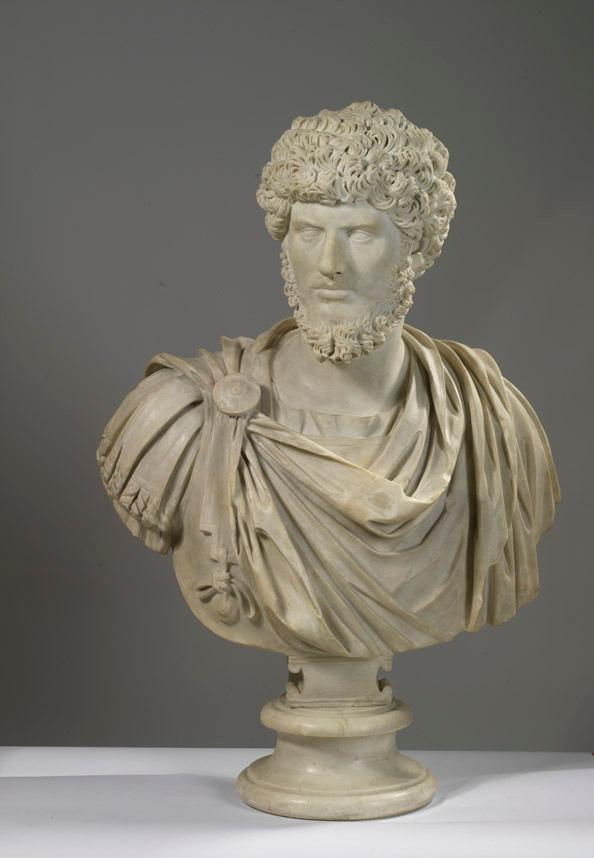
Body Source: Waywell, The Lever and Hope Sculptures, 41, 97. Image Source: collections.rom.ca
Cinerary Basket

The provenance of this Roman cinerary urn is unknown, but it has been dated to the early Imperial period (c. 10 BC – 10 AD). It was also displayed in the Duchess Street Picture Gallery from 1804, and moved to the Theatre of the Arts at Deepdene in 1824. In Williams’s watercolour, it is depicted on a plinth in the bottom row, fourth from the right, supporting a herm with masks. Sold in 1917, it was later presented to the Metropolitan Museum in New York by Mrs. Frederick E. Guest, where it remains to this day.
Although it is a funerary urn in function, it is carved in the form of a basket with a lid. Made of a non-descript marble, it has been scrubbed quite aggressively, although some incrustation remains in the grooves. Basket-urns of this type were apparently popular in Rome in the period of its creation, however, few examples exist today. The most notable is held in the Vatican, while another, found in the tomb of Eurysaces near Porta Maggiore in Rome, has been lost. Like the provenance, the significance of Hope’s basket-type urn is uncertain. Because weaving was a practice associated with “virtuous Roman matrons,” as the Met’s curators suggest, such urns have been linked to female burials. Speculative associations with the “cista mystica, or covered basket, of Bacchic rites” have been made, but with little evidence to take them further.
Body Source: Waywell, The Lever and Hope Sculptures, 106. Image: metmuseum.org
Peplophorus
The exact provenance of the Peplophoros with Archaising Head is unknown. The statue, in Parian marble, is such an accurate recreation of Classical and earlier styles that Christie’s initially assumed it was Greek, and dated it to 500-460 BC, though now it is thought to be from the 1st century (BC). It is unknown when exactly Thomas Hope acquired it, but it was displayed in the Picture Gallery at Duchess Street from 1804 until 1824, then moved to Deepdene and placed in the first niche in the Theatre of the Arts, where it is clearly visible on the far right in Williams’s watercolour.
Hope’s Peplophoros is a copy of a Greek original. The pose is “sub-Archaic,” with her left foot in front of the right and the left hand pulling the skirt in the korai fashion (Waywell, 80). Fittingly, the dress (or peplos, which is a body-length outer garment or robe, drawn in at the waist and falling in straight folds from there to the feet) is in a simplified style, recalling certain Olympia statues–which may have contributed to errors in dating. Interestingly, there are drill holes on the front, for a metal girdle, and similar holes on the feet, for metal sandal straps (also missing). A drill was also used to create her elaborate hairstyle, which stretches around the forehead into a tight bun at the neck. The head attached to Hope’s Peplophoros, although ancient, is not from the original statue; it has subsequently been removed. The right arm was broken off at some point, but reattached. Some restoration is evident to parts of the clothing, the right hand, wrist, neck, and face (Waywell, 80). As Waywell reports, the (restored) right hand “once held petals of [a] flower in a delicate gesture.”
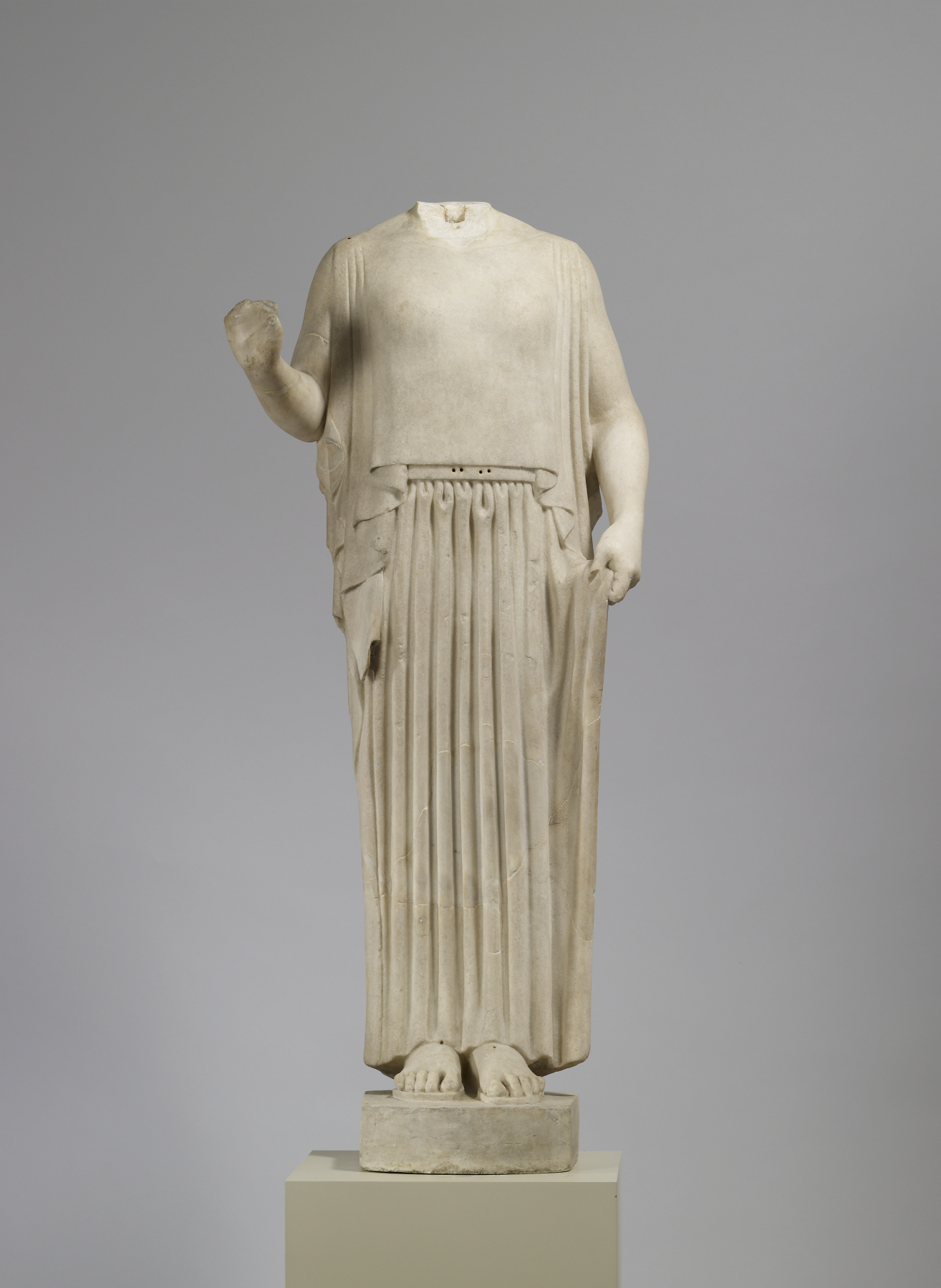
At the time of Hope’s acquisition, Peplophorus was thought to have been a statue of the Roman goddess Isis. This was, and remains, plausible, since many statues of this type were associated with the Roman goddess. At the sale in 1917, the statue was sold to Wallis, and subsequently to Henry Walter in 1930. A year later, it was bequeathed to the Walters Art Gallery in Baltimore.
Body Source: Waywell, The Lever and Hope Sculptures, 80. Image Source: art.thewalters.org
Silenus
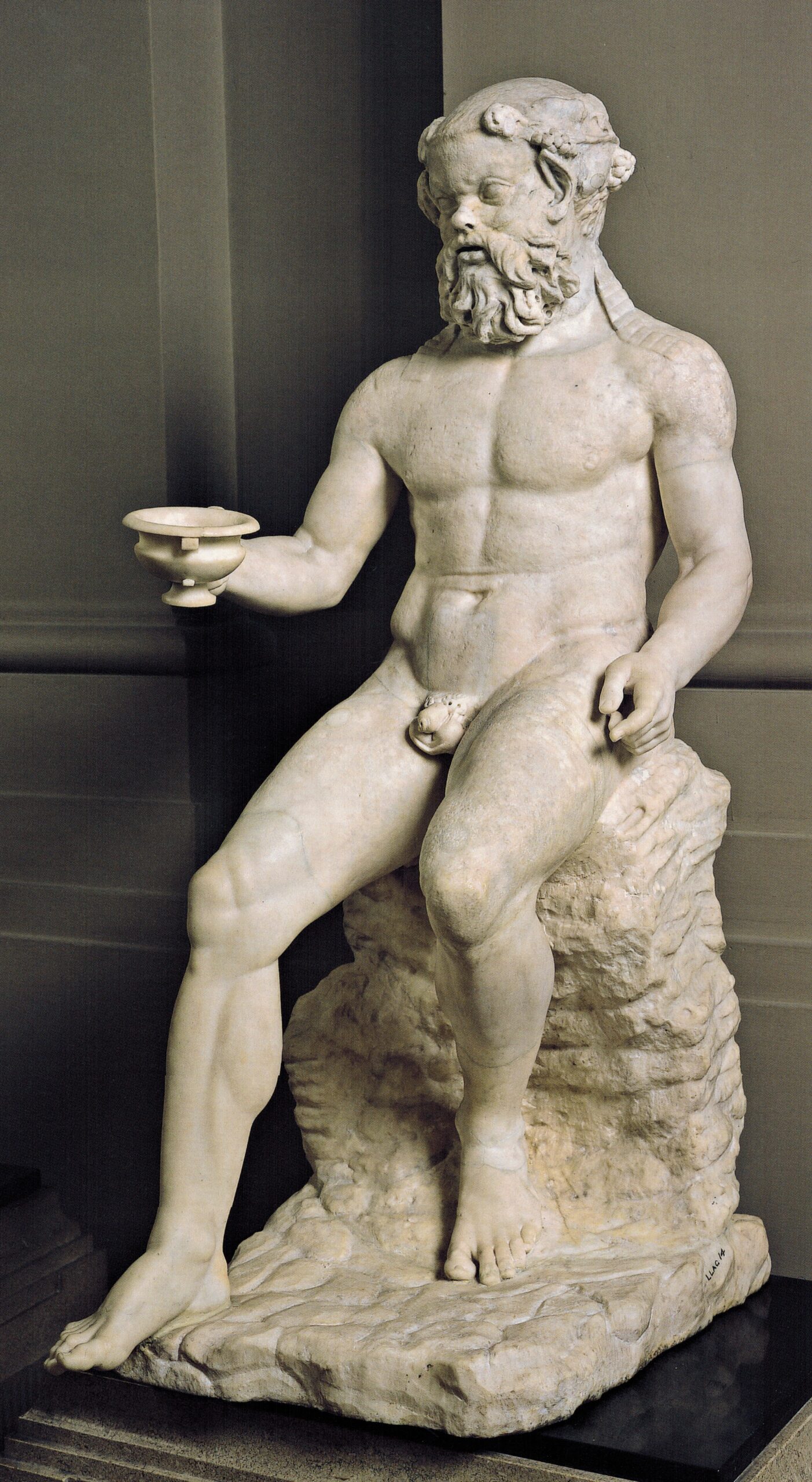
Hope’s Papposilenus Seated on a Rock is dated to the second century AD, with restorations from the eighteenth century. The statue, made of a now-weathered, white, fine-crystalled Greek marble, depicts Papposilenus, the foster father of Dionysus, sitting upright on a stone. In his extended right hand, he holds a drinking cup; his left probably once held a wine jug. His bearded head sports an ivy wreath from which clusters of berries hang. He is visibly well toned, as befits a mature athlete; and his position is thought to be based on the Heracles Epitrapezius by Lysippus (4th century BC). It was bought by Hope, possibly in 1800, at Christie’s auction house in London. In the Deepdene Statue Gallery, it occupied an elevated position in the apse, playfully presiding over the other artifacts, as Williams’s watercolour shows. After the 1917 sale, it made its way, along with other Hope sculptures, into the Lady Lever Art Gallery, which opened in 1922.
Like many statues in Hope’s collection, extensive repairs had been undertaken to make it suitable for the collector’s market. Modern additions were principally to fill gaps: breaks were smoothed to add attachments, but otherwise, original, salvageable pieces were used. For example, both thighs were rebuilt with smooth-seamed marble patches; most of the upper-right thigh is ancient and original, but the lower limb, foot, and front plinth are modern, made obvious by a neater connection as well as the dissimilar surface condition and material. The once-broken-off-head has been masterfully reattached to the neck by an even-seamed marble disk. The realistic face, featuring a mouth slightly ajar and a cocked eyebrow, conveys a mischievous sense of enjoyment. The high quality of the repairs reflects the preference on the part of eighteenth-century collectors for smooth, highly finished sculptures, and a tendency to treat them as “glorified furniture”–“ruined” or fragmentary sculptures were not yet valued on their own terms. Paradoxically this preference, which demanded a high level of artistry and craftsmanship, also contributed to their long term preservation in modified (or at least partially ‘original’) form. Hope’s Papposilenus Seated on a Rock, unusual in treating this minor god of the woodland as relatively dignified rather than simply as a buffoon, or a drunken old silen, is perhaps one of the finest examples of this.
Sources: Waywell, The Lever and Hope Sculptures, 20; Watkin and Hewat-Jaboor, ed., Thomas Hope: Regency Designer, 310.
Psyche
Psyche was created by the Danish sculptor Bertel Thorvaldsen (1770-1844) between 1807 and 1809, based on a model he made in 1806. We don’t know exactly when Hope acquired Psyche, but the statue is thought to have been a gift from his brother, Henry Philip Hope, who bought it directly from the sculptor. Sold to Humbert & Flint in the 1917 sale, the sculpture now resides in the Thorvaldsen Museum, in Copenhagen.
The statue presents Psyche glancing demurely downwards, her winged figure holding a vase (the ‘jar of beauty’), and her flowing hair drawn up into a tight bun. Below the waist, the drapery is tightly knotted to cover the genitalia, and falls to cover all but her toes. David Bindman describes the statue as one in a series of chaste, ideal figures (such as Hebe and Venus) that contrast with the more sensuous versions of these figures made by Canova, suggesting that Hope preferred the more austere qualities of Thorvaldsen’s work. Indeed, in 1803, Hope commissioned him to create Jason with the Golden Fleece, and later, portrait busts of a number of family members, reflecting Hope’s active patronage of contemporary artists and sculptors. (Later, however, he did buy from Canova the celebrated Hope Venus, currently in the Leeds Art Gallery). Psyche was given a place of great importance at Deepdene, in a dedicated niche at the far end of the Conservatory from the Theatre of the Arts. In this circular, raised area, she overlooks the Conservatory’s lush greenery, with a mirrored panel behind her amplifying the co-presence of nature and art, as well as the interpenetration of garden and gallery–suggesting, in a playful, material double-entendre, that this was an appropriate place for the human psyche to reflect and contemplate, as well as a deft manifestation of Hope’s picturesque aesthetic program.
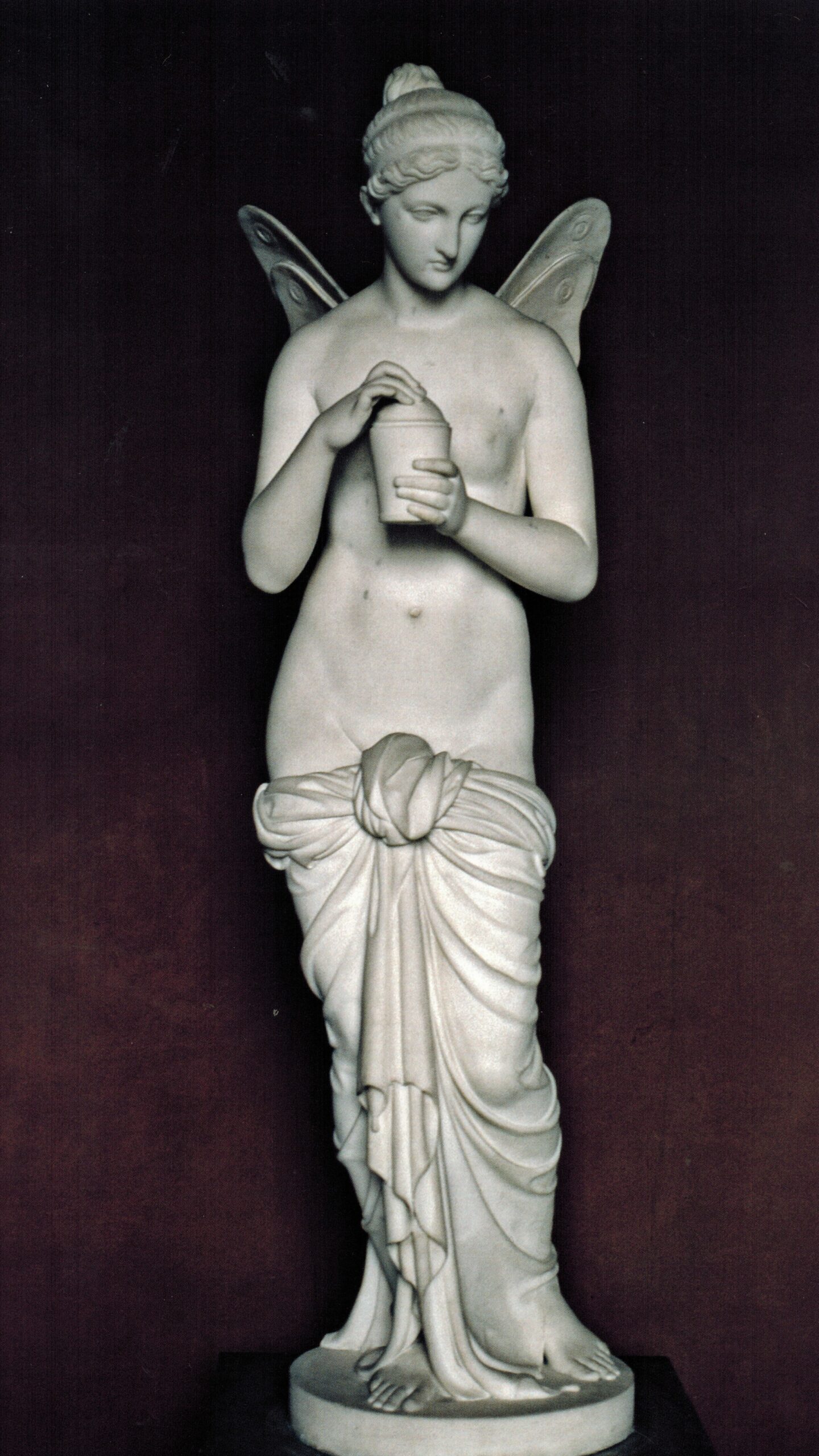
Source: Watkin and Hewat-Jaboor, ed., Thomas Hope: Regency Designer, 354.